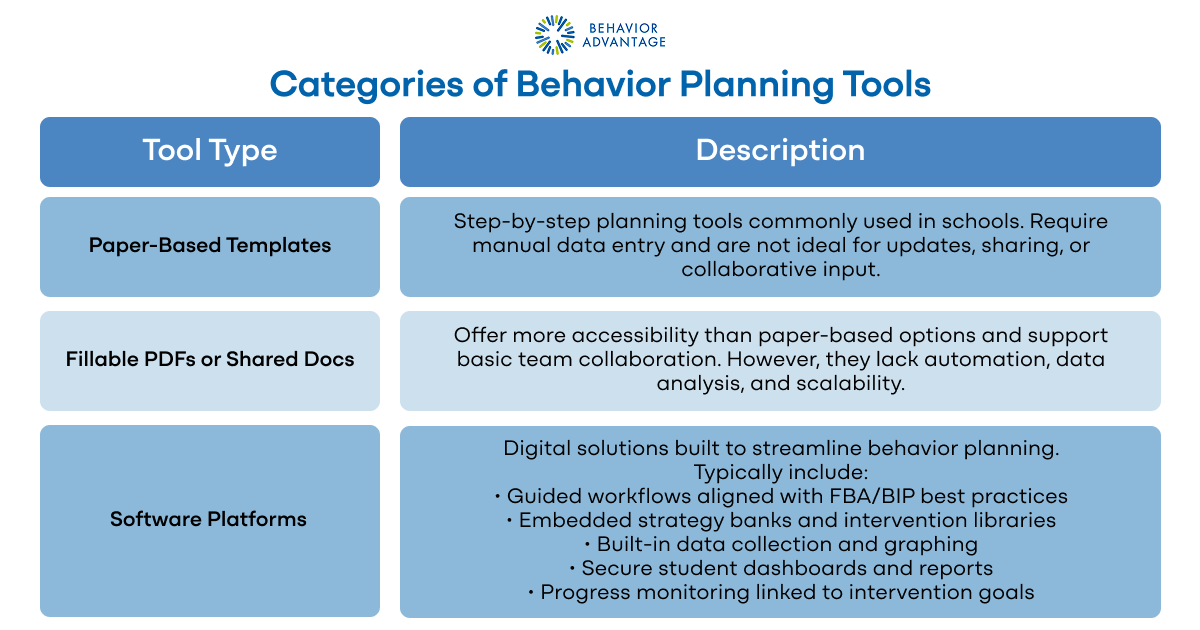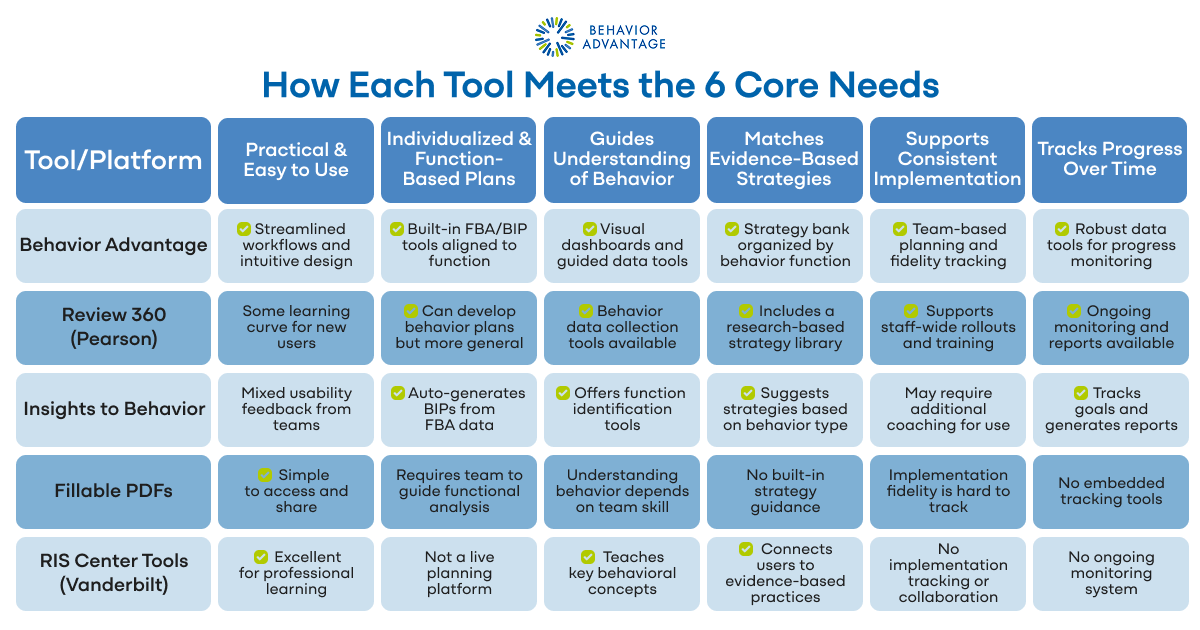What Is Behavior Planning and Why It Matters
Behavior planning means understanding and supporting student behavior using proven, practical strategies. It’s especially important for students who need more than just general classroom supports—those who benefit from targeted or intensive interventions within a Multi-Tiered System of Supports (MTSS).
At its core, a good behavior plan:
- Identifies the why behaviors happen (the function)
- Connects data to effective strategies
- Focuses on prevention and teaching replacement skills
- Tracks progress and fidelity over time
Behavior planning tools help school teams implement this process with clarity and consistency—espcially when time, training, or resources are limited.
Curious about behavior planning tools? Our latest blog covers what they are, why they’re essential, and how to choose the right one.
It’s easy to get excited by a long list of features and dashboards. But the best tool is the one that helps your team focus on what really matters: supporting students and empowering teachers. Keeping your goals front and center will help you choose a tool that’s both practical and powerful.
What to Look for in Behavior Planning Software
Here are six must have features to consider:
- Practical, Efficient, and Easy to Use
Time-saving workflows and intuitive interfaces reduce the burden on teachers and support staff.
- Ability to Create Individualized, Function-Based Plans
Supports the development of behavior intervention plans (BIPs) tailored to individual student needs, based on behavior function and context. - Support for Understanding Behavior Context and Function
Tools should guide teams through behavior hypotheses, triggers, and patterns. - Alignment to Evidence-Based Strategies
Effective platforms match interventions to behavior function and research-backed practices. - Promote Consistent Implementation
Teams need clear instructions, documentation, and shared access to support fidelity. - Ongoing, Practical Progress Monitoring
Built-in tracking tools help teams adjust interventions based on student response and data trends.
Looking for the Right Behavior Planning Tool?
Before choosing, consider how different categories of behavior planning tools fit your organization’s needs. Often, having more than one tool in your behavior planning toolbox makes the most sense.
Categories of Behavior Planning Tools

How Well Do These Tools Meet Real Educator Needs?
Feature lists and shiny dashboards can be overwhelming. The best tools are the ones your team will actually use—and that make a difference for students.
We focused on six core needs important in real schools:
- Practicality and ease of use
- Ability to create individualized, function-based plans Make sure to check out our BIP guide, packed with step-by-step tips.Support for understanding behavior context and function
- Alignment with evidence-based strategies
- Promotion of consistent implementation
- Progress tracking over time
To help you compare, here’s a snapshot of five popular behavior planning tools based on information from their websites. This overview highlights how they support day-to-day implementation, consistency, compliance, and meaningful behavior change.
Tools Compared
- Behavior Advantage
- Review360 (Pearson)
- Insights to Behavior
- Fillable PDFs
- Iris Center Tools (Vanderbilt University)
How Each Tool Meets the 6 Core Needs

Quick Summary
- Behavior Advantage shines with a user-friendly design, guided workflows, and real-time monitoring. It works well for both IEP and 504 teams.
- Review360 is robust, especially for districts already using Pearson products, but may require more upfront training.
- Insights to Behavior automates plan creation but may need extra coaching and customization.
- Fillable PDFs remain a popular low-cost option, but they lack automation, fidelity tracking, and real time data tools.
- IRIS Center Tools are great for training but don’t support live planning or monitoring.
Final Tips for Selecting a Behavior Planning Tool
Picking the right tool isn’t just about features—it’s about what fits your team’s workflow and students’ needs.
Ask yourself:
- What behavior support tier(s) do we need to cover?
- Do we need digital workflow support, or will manual tracking work?
- Is legal compliance and documentation a priority?
- Do we want tools that include professional learning and coaching?
- Will this tool help connect compliance with meaningful behavior change?
The best tool is the one your team will actually use consistently—one that simplifies planning, encourages collaboration, and drives student success.
Bottom Line
The right behavior planning tool makes your team’s job easier, not harder. Platforms like Behavior Advantage stand out because they’re built for real school settings, with workflows that align with how educators think, plan, and respond. Whether managing Tier 2 supports or intensive behavior plans, it offers clarity, structure, and support to help schools move from compliance to impact.
Ready to Find a Behavior Planning Tool That Actually Works?
If you’re searching for a practical, MTSS-aligned behavior planning tool that helps your team create individualized plans, apply evidence-based strategies, and monitor progress with ease, Behavior Advantage is built to do just that.
Explore how it can support Tier 2 and Tier 3 behavior interventions, streamline your planning process, and promote real change for students.









